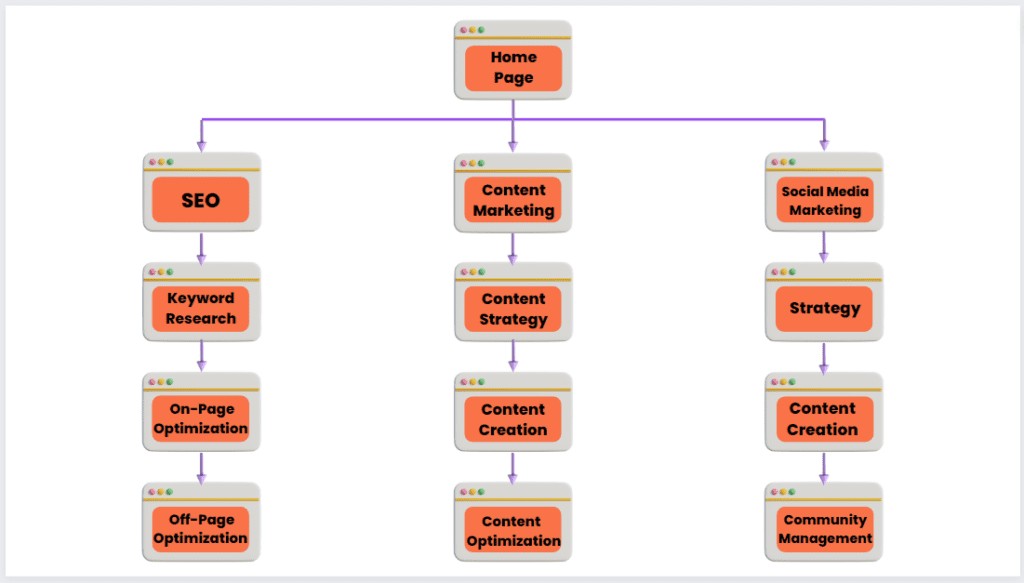Implementing an effective content silo structure is a crucial aspect of search engine optimization (SEO) that can significantly impact your website’s organic traffic and overall performance. By organizing your content into relevant categories or topics, content silos break down barriers, enhance user experience, and improve search engine visibility.
In this article, we will explore what a content silo structure entails, its importance for SEO and website traffic growth, and provide a step-by-step guide on how to create an effective content silo structure.
What is Silo Structure in SEO?
A content silo structure refers to the organization of website content into distinct and tightly themed categories or topics. Each content silo serves as a container for related content, creating a logical and hierarchical structure. By grouping similar content together, search engines can better understand the topical relevance of your website, thereby improving its visibility and ranking potential in search results.
Why It Is Important for SEO and Website Traffic Growth?
Implementing a content silo structure offers several benefits for SEO and website traffic growth:
Enhanced Website Navigation
Content silos facilitate intuitive navigation for website visitors. By presenting content in a well-structured and organized manner, users can easily find the information they seek, leading to improved user engagement and satisfaction.
Increased Keyword Relevance
It allow you to align your website content with relevant keywords and search queries. By focusing on specific topics within each silo, you can optimize your content for targeted keywords, increasing its relevance to search engines.
Improved Internal Linking
A content silo structure enables effective internal linking between related content within the same silo. By linking pages together, you establish thematic connections, which not only aid search engines in understanding the relationships between your content but also enhance user navigation and engagement.
Targeted Authority Building
By concentrating on specific topics within each silo, you can develop comprehensive and authoritative content. This targeted approach allows you to establish your website as an authority on specific subjects, attracting relevant organic traffic and potential backlinks.
How to Create an Effective Content Silo Structure?
Now that we understand the importance of a content silo structure, let’s delve into the step-by-step process of creating an effective one for your website:
Keyword Research
Start by conducting thorough keyword research to identify relevant topics and categories for your content silos. Utilize keyword research tools and techniques to uncover high-volume and low-competition keywords that align with your website’s goals and target audience.
Devise a Content Strategy
Based on your keyword research, devise a content strategy that aligns with your content silo structure. Determine the topics you will cover within each silo and create a plan for consistently producing high-quality, informative content that resonates with your target audience.
Integrate Your Blog
If you have a blog section on your website, integrate it into your content silo structure. Categorize your blog posts according to the relevant silo topics, ensuring they contribute to the overall theme and coherence of each silo.
Build Virtual and Physical Silos
Consider the architecture and URL structure of your website to reflect the content silo structure. You can build virtual silos by grouping related content within categories or subfolders, and physical silos by linking relevant pages through navigational menus or sidebar elements.
Map Out Your Content Silo
Create a visual map or diagram of your content silo structure to provide a clear overview of how different topics and categories interrelate. This map will serve as a reference point for organizing and expanding your content silos over time.
Existing Content Structure or Hierarchically
If you have existing content on your website, analyze its relevance to your content silo structure. Organize and categorize the content hierarchically within the appropriate silos, ensuring it contributes to the overall coherence and topical relevance.
Interlinking
Establish internal links between related content within each silo to reinforce the thematic connections. Use descriptive anchor text that incorporates relevant keywords to provide search engines with additional context and improve user navigation.
Page Structure
Optimize the page structure within each silo for enhanced readability and SEO. Utilize headings, subheadings, and formatting to present your content in a well-structured and user-friendly manner. Incorporate relevant keywords naturally while maintaining a logical flow of information.
Also Read: Ultimate SEO Glossary: 499+ Essential SEO Terms You Need to Know!
Common Mistakes in Using Content Silos on Websites or Blogs?
While content silos can be highly beneficial for SEO and website traffic growth, it’s essential to be aware of common mistakes that can hinder their effectiveness:
- Poor Keyword Selection: Failing to conduct comprehensive keyword research may result in targeting irrelevant or highly competitive keywords, limiting the effectiveness of your content silos.
- Inconsistent Content Creation: Inconsistent content creation can disrupt the topical focus of your silos and lead to a disjointed user experience. Maintain a consistent publishing schedule to ensure steady growth within each silo.
- Neglecting Internal Linking: Neglecting internal linking within your silos can limit the flow of link equity and hinder search engines’ understanding of the thematic connections between your content.
How Can You Avoid Them?
To avoid these common mistakes, consider the following tips:
- Conduct thorough keyword research to identify relevant and achievable keywords for your content silos.
- Create a content calendar and stick to a consistent publishing schedule to ensure a steady stream of high-quality content.
- Implement a comprehensive internal linking strategy, ensuring that each piece of content receives appropriate internal links from related pages within the same silo.
How Do You Know If Your Website’s Content Silo Structure Is Effective?
Evaluating the effectiveness of your content silo structure requires monitoring several key indicators:
- Improved Search Rankings: If your content silo structure is working effectively, you should observe improvements in your website’s search engine rankings for relevant keywords within each silo.
- Increased Organic Traffic: An effective content silo structure often leads to increased organic traffic, as search engines recognize the topical relevance and authority of your website.
- Enhanced User Engagement: Analyze metrics such as time on page, bounce rate, and page views to assess whether users are engaging with your content within each silo.
Conclusion
Implementing a content silo structure is a strategic approach that can significantly enhance your website’s SEO performance and drive organic traffic. By organizing your content into distinct and relevant categories, you create a user-friendly experience and improve search engine visibility. Follow the step-by-step guide outlined in this article to create an effective content silo structure.
FAQs
A content silo refers to the organization of website content into distinct and tightly themed categories or topics. It involves grouping related content together to create a logical and hierarchical structure.
The silo technique in SEO involves implementing a content silo structure to organize website content into relevant categories or topics. It aims to improve search engine visibility, user experience, and keyword relevance.
Silo linking involves creating internal links between related content within the same silo. You can accomplish this by using descriptive anchor text that incorporates relevant keywords and linking from one page to another within the silo.
The choice between using subpages or posts to link to pillar content within the silo method in WordPress depends on your website’s structure and content organization. Both options can be effective as long as the chosen approach maintains a clear and logical hierarchy within the content silo structure.






 No publishers in the cart.
No publishers in the cart.